安徽高考英语语法考点大全归纳总结
安徽高考英语短语总结二
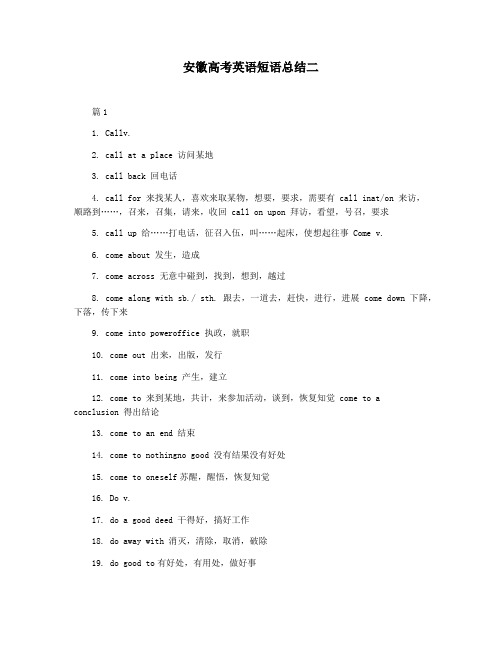
安徽高考英语短语总结二篇11. Callv.2. call at a place 访问某地3. call back 回电话4. call for 来找某人,喜欢来取某物,想要,要求,需要有 call inat/on 来访,顺路到……,召来,召集,请来,收回 call on upon 拜访,看望,号召,要求5. call up 给……打电话,征召入伍,叫……起床,使想起往事 Come v.6. come about 发生,造成7. come across 无意中碰到,找到,想到,越过8. come along with sb./ sth. 跟去,一道去,赶快,进行,进展 come down 下降,下落,传下来9. come into poweroffice 执政,就职10. come out 出来,出版,发行11. come into being 产生,建立12. come to 来到某地,共计,来参加活动,谈到,恢复知觉 come to aconclusion 得出结论13. come to an end 结束14. come to nothingno good 没有结果没有好处15. come to oneself苏醒,醒悟,恢复知觉16. Do v.17. do a good deed 干得好,搞好工作18. do away with 消灭,清除,取消,破除19. do good to有好处,有用处,做好事20. do harm to有害处,不利篇21. do sb. a favour 帮个忙2. do one good对某人有好处3. do one’s best 尽力,竭力4. do the deed 付诸行动,生效5. do one’s duty 履行职责6. do up 收拾,整理,修理,打扮,包,捆,系7. do with 处理,需要,想,将就用8. do wonders 创造奇迹9. do wrong right 做错对10. have sth. nothingto do with和……有无关11. Downadv.12. bring down 使倒下,击落13. break down 分解14. burn down把……烧成平地,烧光15. get down to 开始认真做某事16. hand down 把……传下来17. put down记下,镇压18. tear down 拆毁,拆除19. turn down 关小,调低篇31. For prep.2. for a while 暂时,一时3. for ever 永远4. for free免费5. for the moment暂时6. be famous for因……而著名7. have a gift for 对……有天赋8. make a plan for 为……作计划9. stand for 代表,象征10.in one’s search for 寻找求11.as for 至于,说到12.care for 喜欢,想要13.change… for用……换14.fix a date for 约定……的日期篇41. Getv.2. get about 消息传开,到处走动3. get along 进行,过活,相处,走开4. get away 逃掉,逃跑5. get away from 避免,摆脱,离开6. get back 回来,收回7. get close to 接近8. get down 记下来,打下来,落下9. get down on one’s knees 屈膝下跪10. get down to 开始认真做某事11. get into the habit of 染上……的习惯12. get hold of 拿到,找到,抓住13. get in 进站,进去,回来,收进去,请来14. get off 起飞,动身离开,脱下衣服等15. get on 某方面进行情况,相处,上车,继续进行,顺利发展16. get on well with 与……相处融洽17. get over 克服,忍受,摆脱疾病等18. get rid of 消灭,摆脱,除掉19. get round 传开,绕过,回避20. get through通过;到达;做完;接通电话;度过,熬过困难时期等 get together 聚会,联欢21. get up 起床,站起来,举办篇51. Give v.2. give a talk 作报告,作演讲3. give away放弃;泄露;出卖;分发4. give birth to 生,产生5. give in 让步,屈服,妥协,投降,交上来6. give off 散发出7. give one’s life 献出自己的生命8. give sb a hand lend sb a hand帮某人忙9. give one’s regardsgreetings to向……问好10. give out 散发,分发11. give up 放弃,献出,交出,投降,认输,泄气感谢您的阅读,祝您生活愉快。
高考英语知识点总结安徽
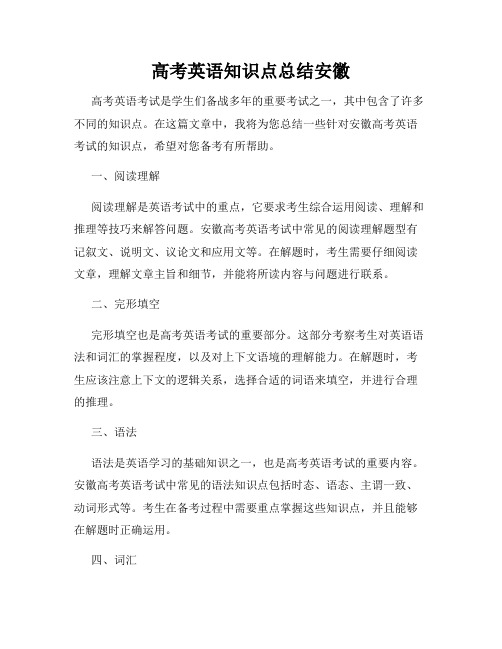
高考英语知识点总结安徽高考英语考试是学生们备战多年的重要考试之一,其中包含了许多不同的知识点。
在这篇文章中,我将为您总结一些针对安徽高考英语考试的知识点,希望对您备考有所帮助。
一、阅读理解阅读理解是英语考试中的重点,它要求考生综合运用阅读、理解和推理等技巧来解答问题。
安徽高考英语考试中常见的阅读理解题型有记叙文、说明文、议论文和应用文等。
在解题时,考生需要仔细阅读文章,理解文章主旨和细节,并能将所读内容与问题进行联系。
二、完形填空完形填空也是高考英语考试的重要部分。
这部分考察考生对英语语法和词汇的掌握程度,以及对上下文语境的理解能力。
在解题时,考生应该注意上下文的逻辑关系,选择合适的词语来填空,并进行合理的推理。
三、语法语法是英语学习的基础知识之一,也是高考英语考试的重要内容。
安徽高考英语考试中常见的语法知识点包括时态、语态、主谓一致、动词形式等。
考生在备考过程中需要重点掌握这些知识点,并且能够在解题时正确运用。
四、词汇词汇是英语学习中不可忽视的一部分,它是理解和运用英语的基础。
在高考英语考试中,词汇考察的形式多种多样,包括词义理解、词组搭配、同义词和反义词等。
考生需要通过大量的阅读和积累来增加自己的词汇量,并且能够在阅读理解和完形填空中准确运用所学的词汇。
五、写作写作是高考英语考试的一部分,它要求考生能够用英语表达清晰、连贯的意思,并且能够合理运用语法和词汇。
在备考过程中,考生可以通过大量的写作练习来提高自己的写作能力,同时要注意语法错误和拼写错误的避免。
六、听力听力是英语考试中重要的一环,它要求考生能够听懂日常对话和文章、提取关键信息,并进行准确的回答。
在备考过程中,考生可以通过多听英语材料来提高自己的听力能力,并且在听力练习中尽量模拟考试环境进行练习。
综上所述,安徽高考英语知识点主要包括阅读理解、完形填空、语法、词汇、写作和听力等内容。
在备考过程中,考生需要重点关注这些知识点,并且通过大量的练习来提高自己的应试能力。
(完整版)高考英语语法知识点总结

专题一定语从句一、关系代词引导的定语从句1、that 指人或物在从句中作主语,宾语或表语which 指物在从句中作主语,宾语或表语(作宾语时可以省略)who 指人在从句中作主语,宾语或表语whom 指人在从句中作宾语whose 指人或物在从句中作定语as 指人或物在从句中作主语,宾语或表语but 指人或物在从句中作主语,宾语或表语注意:指物时,whose+名词=the+名词+of which 或 of which+the+名词2、as 的用法(1)常用于下列结构:such…as; so…as;the same…as; as…as注意:the same…as 表示同一类,不同一个the same…that 表示同一个(2)as与which的区别a、位置不同as可放在主句后,主句前或主句中间;which只能放在主句后。
b、as起连接作用,表达说话人的观点、看法,并指出主句内容的根据或出处,意为“正如,正像”.Which相当于并列句,可以用and this来代替,意为“这一点,这件事’"。
注意:as常用于下列结构:as we know/ as is known to all, as we all can see, as has been said before/above,as might be excepted, as is often the case, 一般不能用which代替as。
C、在从句中作主语时,which既可作系动词be的主语也可作实义动词的主语,而as只可作系动词be的主语。
3、but用作关系代词,相当于who/that…not例:In China there is no one but knows Lei Feng。
二、只用that不用which的情况1、。
先行词为 all , much, everything, nothing , something ,anything, nothing, none, the one 等不定代词时2、先行词被only, any, few, little, no , all, just , very ,right等修饰时。
(英语)安徽2021年分类考试与对口高考高频英语语法集合

虚拟语气一、定义英语中语气:祈使语气、陈述语气、虚拟语气。
虚拟:表示与事情相反的假设,或几乎不可能或根本无法实现的臆想;表示一些建议、命令、请求等的规定。
二、虚拟语气知识点1、辨别if 引导的真实条件句和虚拟条件句的区别If I have time, I will go shopping with you.If I had time, I would go shopping with you.= But in fact I have no time.2、虚拟条件句的主句和从句的构成。
1)如果表示与现在事实相反的假设:If 条件句:if+主语+did/were..,主句:should/would/could/might+动词原形doIf I were you, I should study harder.If I got you position, I would work harder.2)表示与过去事实相反的假设:If 条件句:if+主语+had done/had been,主句:should/would/could/might+have done/been(现在完成)If she had got up earlier, she wouldn’t have been late for class.If I had accepted his advice, I should have made it.3) 表达与将来事实相反的假设:If 条件句:did/were; should + do; were to do主句:should/would/could/might+do (原形)If I were to accept the job, I should receive a lot money.If there should be no sun in the future, the plants would die.=If there were no sun, the plants should die.3、混合时间虚拟语气如果条件句中的巨作和主句的动作并不是同时发生,主句和从句各自按照自己的时间做出相应的改变。
2020安徽高考英语语法考点大全归纳总结

高中英语语法总结第一章主谓一致(一) 语法一致原则: 即主语为单数,谓语用单数,主语为复数,谓语也用复数. 以下为注意事项:1. 单数主语即使后面带有with , along with, together with, like(像), but (除了),except, besides, as well as, no less than, rather than(而不是), including, in addition to 引导的短语, 谓语动词仍用单数.如: Air as well as water is matter. 空气和水都是物质.No one except two servants was late for the dinner. 除了两个仆人外, 没有一个人迟来用餐。
2. 用and连接的并列主语,如果主语是同一个人,同一事,同一概念, 谓语动词用单数, 否则用复数. 如:The poet and writer has come. 那位诗人兼作家来了.(一个人)A hammer and a saw are useful tools. 锤子和锯都是有用的工具. (两样物)用and连接的成对名词习惯上被看成是一个整体, 如:bread and butter(黄油抹面包), knife and fork(刀叉)等作主语时, 谓语动词用单数。
3. 不定式(短语), 动名词(短语), 或从句作主语时, 谓语动词用单数. 如: Serving the people is my great happiness.为人民服务是我最大的幸福.When we’ll go out for an outing has been decided.我们什么时候出去郊游已决定了。
4. 用连接的并列主语被each, every 或no修饰时, 谓语动词用单数.Every boy and every girl likes to go swimming. 每个男孩和每个女孩都喜欢去游泳.No teacher and no student was absent from the meeting. 没有老师也没有学生开会缺席.Each man and (each) woman is asked to help. 每个男人和每个女人都被请去帮忙。
安徽英语高考30个核心考点及答案
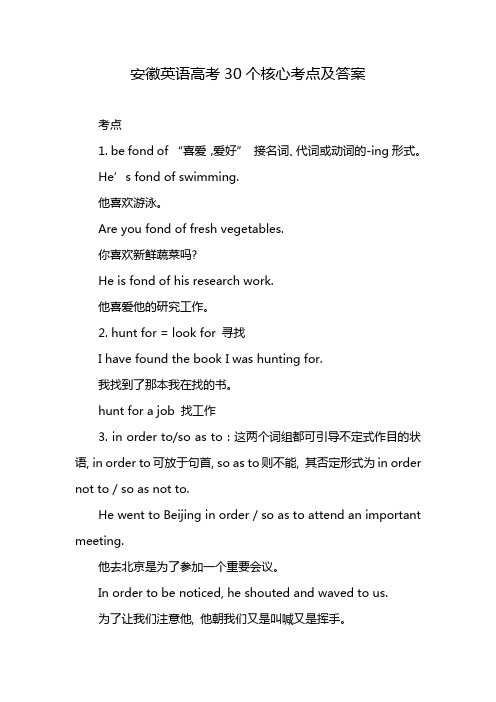
安徽英语高考30个核心考点及答案考点1. be fond of “喜爱,爱好” 接名词、代词或动词的-ing形式。
He’s fond of swimming.他喜欢游泳。
Are you fond of fresh vegetables.你喜欢新鲜蔬菜吗?He is fond of his research work.他喜爱他的研究工作。
2. hunt for = look for 寻找I have found the book I was hunting for.我找到了那本我在找的书。
hunt for a job 找工作3. in order to/so as to:这两个词组都可引导不定式作目的状语, in order to可放于句首, so as to则不能, 其否定形式为in order not to / so as not to.He went to Beijing in order / so as to attend an important meeting.他去北京是为了参加一个重要会议。
In order to be noticed, he shouted and waved to us.为了让我们注意他, 他朝我们又是叫喊又是挥手。
4. care about1) 喜欢,对……有兴趣= care forShe doesn’t care about money.她不喜欢钱。
2)关心= care forShe thinks only of herself. She doesn’t care about other people.她只考虑自己。
她不关心别人。
3)在乎,在意(接从句或不接任何成分)These young people care nothing about what old people might say.这些年轻人根本不在乎老人说的话。
5. such as 意为“诸如……”,“像……”,是用来列举人或事物的。
安徽高考英语知识点

安徽高考英语知识点安徽高考英语科目是高中生的一项重要考试,对于考生来说,掌握好英语知识点是非常关键的。
下面将介绍一些安徽高考英语的重点知识点,希望对考生能有所帮助。
一、语法知识点1. 时态的运用:包括一般现在时、一般过去时、一般将来时、现在进行时、过去进行时等。
2. 从句的使用:主要包括名词性从句、定语从句和状语从句。
3. 被动语态:对动词的主动和被动形式进行转换。
4. 感叹句和倒装句的结构和使用。
二、阅读理解知识点1. 阅读策略:快速阅读、略读和仔细阅读的技巧。
2. 主旨大意题:通过段落的标题和首尾段的概括,来把握文章的中心思想。
3. 细节理解题:通过对文章内容的仔细阅读,找到具体的事实细节。
4. 推理判断题:根据文章的信息和线索,进行合理推理和判断。
5. 词义猜测题:通过上下文的语境,猜测词语的含义。
三、写作知识点1. 作文结构:写作的开头、中间和结尾的组织和衔接。
2. 范文模板:写作过程中可以参考一些范文模板,来提高作文的质量。
3. 语法和词汇表达:正确使用语法和词汇,使作文更加地连贯和丰富。
4. 逻辑思维:对于论点和论据的逻辑推理,提高作文的逻辑性。
四、听力技巧知识点1. 主旨大意题:通过听力材料的整体把握,找出材料的主题或中心思想。
2. 细节理解题:听取关键信息,找出具体的事实细节。
3. 推理判断题:通过对听力材料的信息进行推理,判断其逻辑关系。
4. 补全对话和短文:通过补全缺失的信息,构成完整的对话和短文。
五、词汇和语法知识点1. 单词:重点掌握常见词汇的词义、词性和用法。
2. 动词时态:强化一般现在时、一般过去时和一般将来时的用法和变换。
3. 连词:了解并灵活运用并列连词、转折连词和因果连词。
六、高频考点1. 阅读理解:通常题材包括社会生活、科技教育、文化传统等。
2. 完形填空:主要涉及日常生活、社会环境、科学技术等方面的短文。
3. 短文改错:主要检测对语法和词汇用法的掌握情况。
4. 书面表达:要求根据提示写一篇80-100词的短文。
高考英语合肥语法之简单句知识点知识点总复习附解析
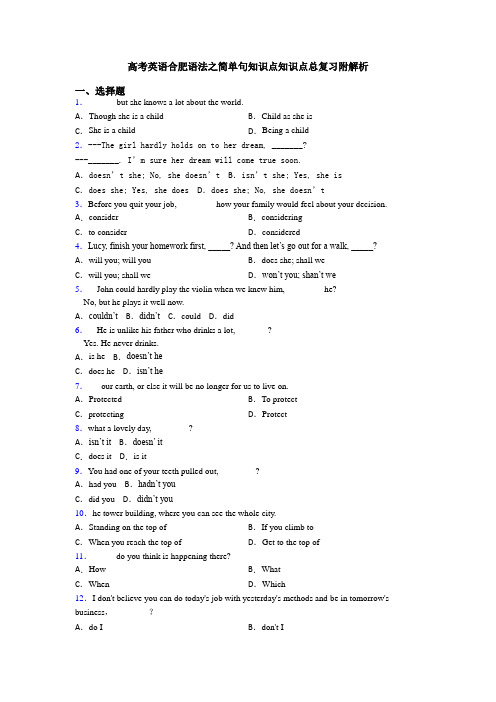
高考英语合肥语法之简单句知识点知识点总复习附解析一、选择题1.______ but she knows a lot about the world.A.Though she is a child B.Child as she isC.She is a child D.Being a child2.---The girl hardly holds on to her dream, _______?---_______. I’m sure her dream will come true soon.A.doesn’t she; No, she doesn’t B.isn’t she; Yes, she isC.does she; Yes, she does D.does she; No, she doesn’t3.Before you quit your job, ________ how your family would feel about your decision. A.consider B.consideringC.to consider D.considered4.Lucy, finish your homework first, _____? And then let’s go out for a walk, _____? A.will you; will you B.does she; shall weC.will you; shall we D.won’t you; shan’t we5.---John could hardly play the violin when we knew him, ________ he?---No, but he plays it well now.A.couldn’t B.didn’t C.could D.did6.---He is unlike his father who drinks a lot, _______?---Yes. He never drinks.A.is he B.doesn’t heC.does he D.isn’t he7.___our earth, or else it will be no longer for us to live on.A.Protected B.To protectC.protecting D.Protect8.what a lovely day, ________?A.isn’t it B.doesn’ itC.does it D.is it9.You had one of your teeth pulled out, ________?A.had you B.hadn’t youC.did you D.didn’t you10.he tower building, where you can see the whole city.A.Standing on the top of B.If you climb toC.When you reach the top of D.Get to the top of11._____ do you think is happening there?A.How B.WhatC.When D.Which12.I don't believe you can do today's job with yesterday's methods and be in tomorrow's business,________?A.do I B.don't IC.can you D.can't you13.________ blood if you can and many lives will be saved.A.Giving B.GivenC.To give D.Give14.Many companies don’t realize ____ important the customers are, which is why they lose their customers unconsciously.A.what B.whether C.how D.which 15.—Look at my new dress.—Wow! ____________ beautiful it is!A.How B.How a C.What D.What a 16.Learning how to repair motors takes a long time,________?A.doesn’t it B.don’t they C.does it D.do they17.I feel like going to the cinema tonight,________?A.don’t I B.don’t you C.do I D.do you18.They must have stayed at home last night,________?A.mustn’t they B.haven’t they C.didn’t they D.must they 19.Let’s start out early tomorrow morning,________?A.shall we B.will you C.do you D.can’t you20.She is unfit for the position,________?A.is she B.isn’t she C.doesn’t she D.does she21.You must have been to the Great Wall,____________?A.mustn’t you B.haven’t you C.aren’t you D.must you 22.—David,you sweep the floor today,_______?—With pleasure.I swept it yesterday,though.A.didn’t you B.do youC.don’t you D.will you23.Attention, please! The participants (参会者) seated at the back of the assembly hall, keep quiet, ________?A.do you B.aren’t they C.will you D.don’t they 24.Judging from what he said, he must have witnessed the incident last week, ______? A.hasn't he B.didn't he C.mustn't he D.wasn't he25.I suppose that you were late this morning, ________?A.am not I B.wasn’t IC.weren’t you D.aren’t you【参考答案】***试卷处理标记,请不要删除一、选择题1.C解析:C【解析】【详解】考查简单句。
高考英语语法必考点与常考点归纳
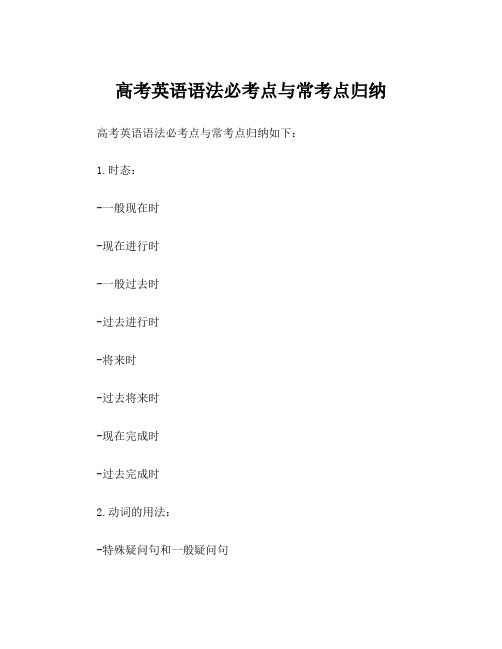
高考英语语法必考点与常考点归纳高考英语语法必考点与常考点归纳如下:
1.时态:
-一般现在时
-现在进行时
-一般过去时
-过去进行时
-将来时
-过去将来时
-现在完成时
-过去完成时
2.动词的用法:
-特殊疑问句和一般疑问句
-被动语态
-否定句
-直接引语和间接引语
3.名词:
-单数和复数形式
-可数和不可数名词
-所有格
4.代词:
-主格、宾格、形容词性物主代词、名词性物主代词-不定代词
5.形容词和副词:
-比较级和最高级
-副词的用法
6.介词:
-表示时间、地点、方式、原因等
7.冠词:
-不定冠词、定冠词和零冠词
8.连词:
-并列连词、从属连词和并列从属连词9.数量词:
-表示数量的词语
10.语态:
-主动语态和被动语态之间的转换11.句子的基本结构:
-主谓结构
-主语从句
-宾语从句
-时间状语从句
-原因状语从句
-结果状语从句
-条件状语从句
-目的状语从句
12.形容词从句和副词从句:
-修饰名词或代词的从句
以上是高考英语语法必考点与常考点的归纳,准备高考的同学们可以结合这些点进行复习。
高考英语13个语法考点 高中英语重点语法知识归纳

高考英语13个语法考点高中英语重点语法知识归纳很多高中生不知道英语语法方面有哪些重点知识,高考英语经常出现的语法考点有哪些呢?下面小编为大家介绍一下! 高考容易出现的13个语法知识总结1. 考查never置于句首时的倒装 当否定副词never置于句首时,其后习惯上要用倒装语序(与一般疑问句形式相同)。
如:(答案分别为BA) (1) Never in my wildest dreams _________ these people are living in such poor conditions. (安徽卷) A. I could imagine B. could I imagine C. I couldn’t imagine D. couldn’t I imagine (2) Never before _________ in greater need of modern public transport than it is today. (上海卷) A. has this city been B. this city has been C. was this city D. this city was 2. 考查little置于句首时的倒装 当否定副词little置于句首时,其后习惯上要用倒装语序(与一般疑问句形式相同)。
如:(答案分别为DD) (1) Little _________ that we were watching his every move, so he seemed to be going his own way in this business. (安徽卷) A. he realized B. he didn’t realize C. didn’t he realize D. did he realize (2) They have a good knowledge of English but little _________ they know。
2021安徽高考高三英语语法知识点最新总结
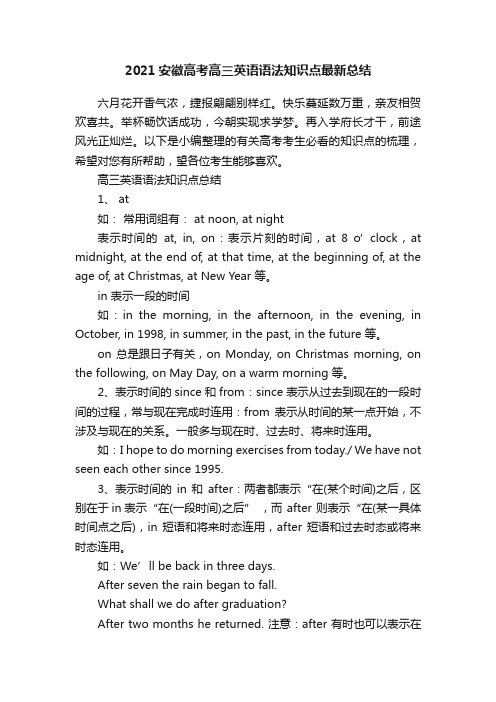
2021安徽高考高三英语语法知识点最新总结六月花开香气浓,捷报翩翩别样红。
快乐蔓延数万重,亲友相贺欢喜共。
举杯畅饮话成功,今朝实现求学梦。
再入学府长才干,前途风光正灿烂。
以下是小编整理的有关高考考生必看的知识点的梳理,希望对您有所帮助,望各位考生能够喜欢。
高三英语语法知识点总结1、 at如:常用词组有: at noon, at night表示时间的at, in, on:表示片刻的时间,at 8 o’clock,at midnight, at the end of, at that time, at the beginning of, at the age of, at Christmas, at New Year 等。
in 表示一段的时间如:in the morning, in the afternoon, in the evening, in October, in 1998, in summer, in the past, in the future 等。
on 总是跟日子有关,on Monday, on Christmas morning, on the following, on May Day, on a warm morning 等。
2、表示时间的 since 和 from:since 表示从过去到现在的一段时间的过程,常与现在完成时连用:from 表示从时间的某一点开始,不涉及与现在的关系。
一般多与现在时、过去时、将来时连用。
如:I hope to do morning exercises from today./ We have not seen each other since 1995.3、表示时间的in 和after:两者都表示“在(某个时间)之后,区别在于in表示“在(一段时间)之后” ,而 after 则表示“在(某一具体时间点之后),in 短语和将来时态连用,after 短语和过去时态或将来时态连用。
安徽英语重要知识点

安徽英语重要知识点英语作文主要的学习科目,那么安徽考生学习英语有哪些重要的知识点呢?接下来店铺为你整理了安徽英语重要知识点,一起来看看吧。
安徽英语重要知识点(一)1.It's time for sb to do sth 是某人做某事的时候了It's time for us to have dinner。
2.keep (on)doing sth 坚持做某事(常考)John always kept (on) asking questions。
keep sb doing sth 让某人做某事(常考)Don't keep me waiting。
keep sb from doing sth 阻止某人做某事(常考)He keeps her from cutting the tree。
keep sb/sth +adj 使某人保持……的状态Washing your hands keeps you healthy。
3.learn to do sth 学做某事Ilearn to play football.learn sth from sb 向某人学习I learn the spirit from him4.like to do/doing sth 喜欢做某事like sb to do sth 喜欢某人做某事She likes swimming./She likes to swim this afternoon。
need to do sth/ need doing sth/need to be done 需要做某事The garden needs to be watered. / The garden needs watering。
5. prefer to do sth rather than do sth 宁愿……而不愿……(常考)I would prefer to spend the weekend at home rather than drive out。
安徽高中英语语法归纳总结
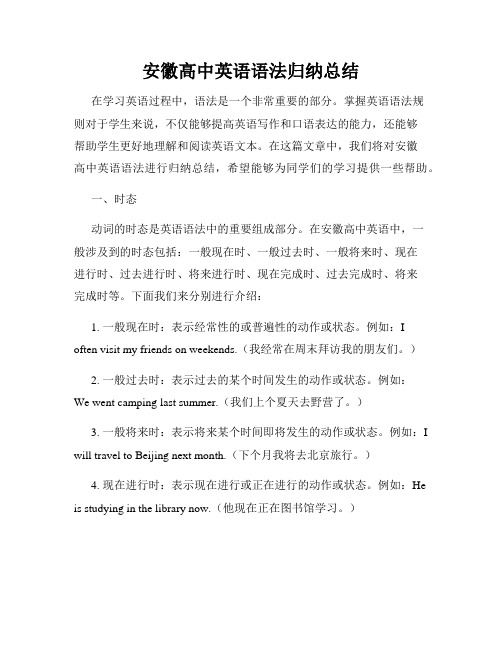
安徽高中英语语法归纳总结在学习英语过程中,语法是一个非常重要的部分。
掌握英语语法规则对于学生来说,不仅能够提高英语写作和口语表达的能力,还能够帮助学生更好地理解和阅读英语文本。
在这篇文章中,我们将对安徽高中英语语法进行归纳总结,希望能够为同学们的学习提供一些帮助。
一、时态动词的时态是英语语法中的重要组成部分。
在安徽高中英语中,一般涉及到的时态包括:一般现在时、一般过去时、一般将来时、现在进行时、过去进行时、将来进行时、现在完成时、过去完成时、将来完成时等。
下面我们来分别进行介绍:1. 一般现在时:表示经常性的或普遍性的动作或状态。
例如:I often visit my friends on weekends.(我经常在周末拜访我的朋友们。
)2. 一般过去时:表示过去的某个时间发生的动作或状态。
例如:We went camping last summer.(我们上个夏天去野营了。
)3. 一般将来时:表示将来某个时间即将发生的动作或状态。
例如:I will travel to Beijing next month.(下个月我将去北京旅行。
)4. 现在进行时:表示现在进行或正在进行的动作或状态。
例如:He is studying in the library now.(他现在正在图书馆学习。
)5. 过去进行时:表示过去某个时间正在进行的动作或状态。
例如:She was watching TV when I called her.(我给她打电话时,她正在看电视。
)6. 将来进行时:表示将来某个时间正在进行的动作或状态。
例如:They will be studying for the exam tomorrow.(他们明天将会一直学习备考。
)7. 现在完成时:表示过去某个时间发生的动作对现在造成的影响或结果。
例如:I have finished my homework.(我已经完成作业了。
)8. 过去完成时:表示过去某个时间之前已经发生的动作或状态。
安徽高考英语常考知识点

安徽高考英语常考知识点高考英语作为中国高考科目之一,对于考生来说是一项非常重要的考试内容。
安徽高考英语考试涵盖了词汇、语法、阅读理解、写作等多个方面的知识点。
下面我们来详细介绍一下安徽高考英语常考的知识点。
一、词汇词汇是英语学习的基础,也是高中英语考试中的重要内容。
考生需要掌握常见的单词、短语、固定搭配等。
1. 常见单词:如person, city, problem, important等。
2. 常见短语:如take care of, look forward to, pay attention to等。
3. 固定搭配:如make a decision, keep in touch, learn from等。
二、语法语法是英语学习中的难点之一。
考生需要熟练掌握各种语法知识,包括时态、语态、主谓一致、虚拟语气等。
1. 时态:包括一般现在时、一般过去时、一般将来时等。
2. 语态:包括主动语态和被动语态。
3. 主谓一致:主语和谓语之间在人称和数上要保持一致。
4. 虚拟语气:表示与事实相反的假设或愿望。
三、阅读理解阅读理解是考试中占比较大的一部分。
考生需要通过阅读短文,理解文章内容,回答相关问题。
1. 阅读技巧:快速浏览文章,了解大意;仔细阅读每个段落,理解细节;注意文章中的词汇和句子结构。
2. 题型分析:包括主旨大意题、细节理解题、推理判断题等。
3. 阅读材料类型:可能涉及新闻报道、社论、广告、说明文等多种文体。
四、写作写作是考核学生英语表达能力的一项重要内容。
考生需要掌握写作技巧,包括句型运用、逻辑顺序、词汇丰富等。
1. 句型运用:使用多种句型,避免句式重复。
2. 逻辑顺序:写作要有条理,段落之间要有过渡。
3. 词汇丰富:使用高级词汇和短语,避免重复使用简单的词汇。
五、听力听力是考试中的一个重要部分,要求考生能够听懂英语对话和文章,准确理解其中的信息。
1. 训练听力:多听英语材料,提高听力能力和反应速度。
安徽高一英语知识点

安徽高一英语知识点高中英语是学生们英语学习的重要阶段,也是他们进一步提高英语水平的关键时期。
为了帮助安徽高一学生更好地掌握英语知识点,以下将针对高一英语知识点进行一些讲解和总结。
一、语法知识点1. 时态:英语中时态的正确运用非常重要。
一般现在时、一般过去时、一般将来时以及各种进行时态的运用是高一英语学习的重点之一。
要注意时态的灵活运用,根据上下文来判断使用哪种时态。
2. 从句:掌握两种从句,宾语从句和定语从句,是高一英语学习的关键。
宾语从句用来作为主句的宾语,定语从句则用来修饰前面的名词。
3. 被动语态:学生们需要掌握被动语态的构成规则以及时间、态的变化规律。
要注意被动语态在句子中的位置和用法。
4. 并列连词:高一英语学习注重学生们正确使用并列连词。
如and、but、or、so等。
要掌握它们的用法,避免无意义的重复。
5. 特殊疑问句:学生们需要熟练掌握特殊疑问句的构成和用法,以便能够准确地提问和回答问题。
二、阅读技巧1. 预测:在阅读文章之前,学生们可以先猜测一下文章的内容,从标题、首句等地方获取一些信息,有助于更好地理解文章。
2. 上下文联系:在阅读过程中,学生们需要通过上下文的联系来理解和推测词义,这样有助于理解整个文章的意思。
3. 主旨句:掌握文章的主旨句非常重要,它可以帮助我们更快地找到文章的关键信息,准确理解文章的大意。
4. 理解段落:学会分析每个段落的主题句,通过理解主题句来把握段落的中心思想,进而理解整个文章的逻辑结构。
三、词汇积累1. 同义词辨析:学生们需要掌握英语中一些词汇的同义词,通过对比辨析来表达更加准确和丰富的意思。
2. 四六级词汇:高一学生们应该开始积累一些四六级词汇,这样有助于他们在日常英语学习和考试中提高。
3. 词根词缀:通过学习一些常用的词根和词缀,可以帮助学生们更好地理解和记忆一些单词。
四、写作技巧1. 句型多样化:学生们需要尝试使用不同的句型,如简单句、并列句、复合句等,以丰富句子结构和提高写作的流畅性。
安徽英语高考知识点

安徽英语高考知识点安徽省高考英语考试中,有一些重要的知识点需要注意和复习。
这些知识点涵盖了英语语法、词汇、阅读理解等方面,对于考生取得好成绩是非常重要的。
下面将分别从这些方面进行介绍。
一、英语语法英语语法是考生必须要掌握的基本知识点。
其中,时态、语态、句式转换、虚拟语气、倒装句等是常考的重点内容。
1. 时态:包括一般现在时、一般过去时、一般将来时、现在进行时、过去进行时、现在完成时、过去完成时等。
需要注意时态在句子中的正确使用。
2. 语态:主动语态和被动语态的转换方法及其在句子中的运用。
3. 句式转换:改写句子的常见方法包括简单句、复合句、疑问句、否定句、倒装句等。
4. 虚拟语气:虚拟语气在条件句、愿望句和建议句等语境中的运用。
5. 倒装句:部分倒装和全部倒装在句子中的使用。
二、英语词汇词汇是理解和运用英语的基础,是高考英语中的重要组成部分。
考生需要注意以下几个方面。
1. 同义词和近义词的辨析,掌握一些常见短语、习惯用语的用法。
2. 词义辨析,对于一些词义相近但用法不同的词汇要进行区分。
3. 词汇搭配:了解一些常见的词语搭配,避免在表达时出现不恰当的搭配。
三、阅读理解阅读理解是英语高考试卷中的重要部分。
考生需要掌握一些阅读理解的技巧。
1. 大意推测:通过阅读短文的首尾段和关键句来推测文章的主旨或段落大意。
2. 细节理解:通过阅读短文获取细节信息,回答与文章内容有关的具体问题。
3. 推理判断:根据文章中的线索进行推理,理解隐含的意思或作者的观点。
4. 表达态度:通过理解作者的观点和态度,进行文章分析和理解。
综上所述,安徽英语高考涉及的知识点主要包括英语语法、词汇和阅读理解。
考生在备考过程中应注重对这些知识点的掌握和运用。
通过针对性的练习和复习,相信大家一定能够在高考中取得优秀的成绩。
祝愿各位考生顺利通过安徽省高考英语考试!。
安徽高考英语短语总结四
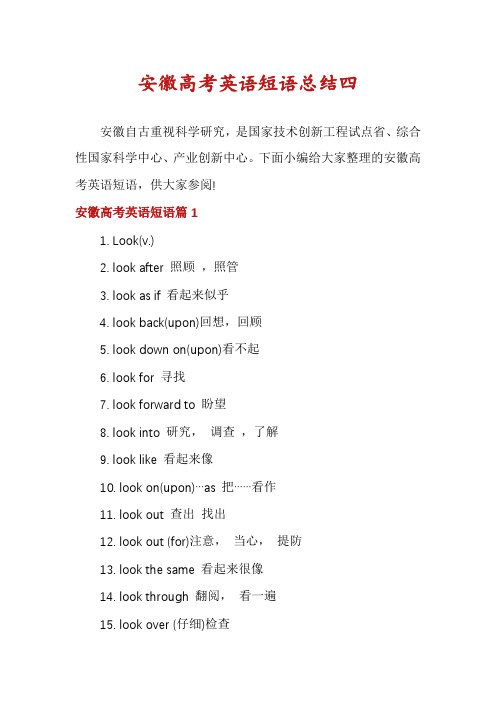
安徽高考英语短语总结四安徽自古重视科学研究,是国家技术创新工程试点省、综合性国家科学中心、产业创新中心。
下面小编给大家整理的安徽高考英语短语,供大家参阅!安徽高考英语短语篇11. Look(v.)2. look after 照顾,照管3. look as if 看起来似乎4. look back(upon)回想,回顾5. look down on(upon)看不起6. look for 寻找7. look forward to 盼望8. look into 研究,调查,了解9. look like 看起来像10. look on(upon)…as 把……看作11. look out 查出找出12. look out (for)注意,当心,提防13. look the same 看起来很像14. look through 翻阅,看一遍15. look over (仔细)检查16. look up 查找,上涨,好转,向上看安徽高考英语短语篇21. Make(v.)2. make clear 说明,弄(讲)清楚3. make a decision 作出决定4. make a promise 答应,允诺5. make a plan for 为……作计划6. make a record 录制唱片7. make friends (with)(和…)交朋友8. make faces 做鬼脸9. make fun of 和开玩笑10. make a noise 吵闹11. make it a rule 总是……12. make one’s way to(out of)向… 走去(从…走出) make ends meet 应付开支,量入为出13. make room 让地方14. make sense 讲得通,很有意义15. make sure(certain)一定要,确保,核实,弄清楚make …to one’s own measure 依照某人的尺寸做……16. make up one’s mind 决心,利用17. make use of 利用1. Of(prep.)2. a bit of少量的,一点3. a bottle of 一瓶4. a glass of 一(玻璃)杯5. a great deal of 很多6. a handful of 少量的7. a (large)number of 许多8. a lot of 许多,大量的9. lots of 许许多多的10. a piece of 一片(张,块)11. a place of interest 名胜12. a pair of 一双,一对13. a waste of 浪费14. all kinds of 各种各样的15. all sorts of各种各样的16. at the head of 在……的前头17. at the mercy of 在……的支配下18. because of 因为19. be made up of 由……组成20. be proud of 为……而自豪1. be fond of 爱好,喜欢2. be tired of 厌烦3. die of 死于4. dream of 向往,渴望,梦想5. get rid of 处理,去掉6. in charge of 主管,负责7. in the charge of 由……掌管8. in honour of 为了纪念,为向……表示敬意9. instead of 代替10. in the hope of 怀着……的期望11. in spite of 尽管12. knock out of 从……中敲出来13. make fun of 取笑某人14. make sure of 确定,弄清楚15. make use of 利用安徽高考英语短语篇51. masses of 大多数2. packs of 大量的,大部分3. play the role of 扮演……角色4. out of 从……向(往)外5. on the point of 正要……的时候6. plenty of 充足的,相当多的7. a quantity/quantities of 许多的,大量的8. remind sb of 使某人想起9. run out of 用完10. scores of 许多,大量11. take the place of 代替,取代12. talk of 谈论,议论13. think of 认为,想到,想起14. take possession of占有,拥有。
- 1、下载文档前请自行甄别文档内容的完整性,平台不提供额外的编辑、内容补充、找答案等附加服务。
- 2、"仅部分预览"的文档,不可在线预览部分如存在完整性等问题,可反馈申请退款(可完整预览的文档不适用该条件!)。
- 3、如文档侵犯您的权益,请联系客服反馈,我们会尽快为您处理(人工客服工作时间:9:00-18:30)。
高中英语语法总结第一章主谓一致(一) 语法一致原则: 即主语为单数,谓语用单数,主语为复数,谓语也用复数. 以下为注意事项:1. 单数主语即使后面带有with , along with, together with, like(像), but (除了),except, besides, as well as, no less than, rather than(而不是), including, in addition to 引导的短语, 谓语动词仍用单数.如: Air as well as water is matter. 空气和水都是物质.No one except two servants was late for the dinner. 除了两个仆人外, 没有一个人迟来用餐。
2. 用and连接的并列主语,如果主语是同一个人,同一事,同一概念, 谓语动词用单数, 否则用复数. 如:The poet and writer has come. 那位诗人兼作家来了.(一个人)A hammer and a saw are useful tools. 锤子和锯都是有用的工具. (两样物)用and连接的成对名词习惯上被看成是一个整体, 如:bread and butter(黄油抹面包), knife and fork(刀叉)等作主语时, 谓语动词用单数。
3. 不定式(短语), 动名词(短语), 或从句作主语时, 谓语动词用单数. 如: Serving the people is my great happiness.为人民服务是我最大的幸福.When we’ll go out for an outing has been decided.我们什么时候出去郊游已决定了。
4. 用连接的并列主语被each, every 或no修饰时, 谓语动词用单数.Every boy and every girl likes to go swimming. 每个男孩和每个女孩都喜欢去游泳.No teacher and no student was absent from the meeting. 没有老师也没有学生开会缺席.Each man and (each) woman is asked to help. 每个男人和每个女人都被请去帮忙。
5. each of + 复数代词, 谓语动词用单数. 复数代词+each, 谓语动词用单数.如:Each of us has something to say. 我们每个人都有话要说。
6. 若主语中有more than one 或many a/an , 尽管从意义上看是复数, 但它的谓语动词仍用单数。
但more+复数名词+than one做主语时, 谓语动词仍用复数. 如: Many a boy likes playing basketball. 许多男生都喜欢打篮球.More than one student was late. 不只一个学生迟到More persons than one come to help us. 不止一个人来帮助我们。
7. none 做主语时,谓语动词可用单数, 也可用复数; 但在代表不可数的东西时总是看作单数,因而谓语动词要用单数. 如:None of us are (is) perfect. 人无完人。
None of this worries me. 这事一点不使我着急。
8. 名词如: trousers, scissors, clothes, goods, glasses 等作主语时, 谓语动词必须用复数. 如:His clothes are good. 但这些名词前若出现a pair of , 谓语一般用单数.如:A pair of glasses is on the desk. 桌上有一副眼镜。
9. 形复意单名词如:news ; 以ics 结尾的学科名称如: physics, mathematics, economics; 国名如: the United States; 报纸名如: the New Times; 书名如: Arabian Night <天方夜谈>; 以及The United Nations<联合国> 等作主语时, 谓语动词用单数。
10. “a +名词+and a half “, “one and a half + 名词”, “the number of + 名词”等作主语时, 谓语动词要用单数. 如:Only one and a half apples is left on the table.注意: one or two + 复数名词作主语, 谓语动词用复数形式, 如:One or two places have been visited. 参观了一两个地点。
(二) 内容一致原则:1.主语中有all, half, most, the rest等, 以及”分数或百分数+名词”做主语时,谓语动词单复数取决于连用的名词.如:The rest of the bikes are on sale today. 剩下的自行车,今天出售。
60%of the apple was eaten by little boy. 这个苹果的60%都被这个小男孩吃了。
Most of the apples were rotten. 大部分的苹果都是烂的。
Most of the apple was eaten by a rat. 这个苹果的大部分被老鼠吃了。
2. 不定数量的词组, 如:part of , a lot of , lots of , one of , a number of , plenty of等作主语时, 谓语动词的单复数取决于量词后面名词的数.如:A part of the textbooks have arrived. 一小部分教科书已运到。
A part of the apple has been eaten up by the pig. 这个苹果的一部分被猪吃光了。
3. 加减乘除用单数.如:Fifteen minus five is ten . 15减去5等于10。
4. 表示时间, 金钱, 距离, 度量等的名词做主语时, 尽管是复数形式, 它们做为一个单一的概念时, 其谓语动词用单数.如:Ten miles is a good distance. 十英里是一个相当的距离。
5. (1) 通常作复数的集体名词. 包括police , people, cattle 等, 这些集体名词通常用作复数.如:The British police have only very limited powers.(2) 通常作不可数名词的集体名词. 包括equipment, furniture, clothing, luggage 等.(3) 可作单数也可作复数的集体名词. 包括audience, committee, government, family, enemy, group, party, team, public 等.如:The committee has/have decided to dismiss him. 委员会决定解雇他。
6. the +形容词/过去分词形式”表示一类人或事物, 作主语时, 谓语动词用复数.如:The injured were saved after the fire.(三) 就近原则1. 由here, there, where 等引导的倒装句中, (有时主语不止一个时)谓语动词与靠近它的主语在数上一致.如:Here comes the bus 公共汽车来了.Here is a pen and some pieces of paper for you. 给你一支钢笔和几张纸。
Where is your wife and children to stay while you are away?你不在这儿的时候, 你爱人和孩子在哪儿呆呢?2. 用连词or, either.... or, neither….nor, not only….but also 等连接的并列主语, 谓语动词与靠近它的主语在数上一致。
如:Neither the students nor the teacher knows anything about it 学生和老师都不知道这事.He or you have taken my pen. 他或你拿了我的钢笔。
注意: one of +复数名词+who/that/which 引导的定语从句中, 定语从句的动词为复数。
如:Mary is one of those people who keep pets. 玛丽是饲养宠物者之一。
The only one of +复数名词+ who/that./which 引导的定语从句中,定语从句的动词应为单数。
Mary is the only one of those people who keeps pets. 玛丽是唯一一个饲养宠物的人。
第二章:非谓语动词不定式(infinitive)、分词(participle)、动名词(gerund)是非谓语动词,在句..子中不能作谓语.......。
以下表格列出了他们各自在句中的作用。
(√表示可以在句中担任的语法成分,×则表示不可以。
)作用种类主语宾语宾语补足语表语定语状语不定式√√√√√√动名词√√×√√×分词××√√√√非谓语动词在句中的特点、性质、用法、区别及使用注意事项分述如下:第一节、非谓语动词作主语可作主语的非谓语形式为:不定式和动名词。
其表达形式为:不定式:主动态to do; 被动态to be done; 动名词:主动态doing; 被动态being done。
例1:To act like that is foolish.例2:It is impossible for me to buy the car with cash. 要我用现金买那辆车是不可能的。
例3:Walking is a good form of exercise for both young and old.例4:——What made you so late for work today ?——Driving to the office was very slow this morning because of heavy traffic.因为交通拥挤,今早开车上班非常慢。
一般说来,动名词和不定式作主语,可以互换,其意义没有多大差别,但须注意以下两点:1.表示具体的,尤其是未发生的动作,倾向用不定式(如例2)。
